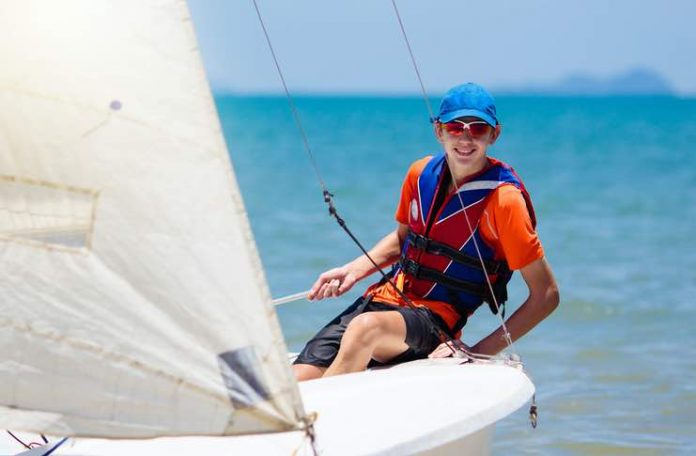
Boating can be fun, stress-reducing, and extremely enjoyable activity–that is, if you know what you’re doing. While boating can be relaxing and entertaining at the same time, it is a water activity and can be potentially dangerous. In this post, we’ll give you our Boating 101 tips.
To lessen any risks or dangers involving boating, there are guidelines to be followed and precautions that should be taken before you even step onboard. It is vital for all those who participate in the boating experience to know the basic information of how to operate a boat or even ride in one.
This includes the proper vocabulary and terms of boating and the safety rules that apply as well. It is imperative for the safety of everyone that these regulations are met and understood.
Boating 101: Terminology & Safety
1. Terminology
Before embarking on a boat for a fun filled trip, it’s vital to know and understand the terminology of the vehicle you are commanding. Both navigators and passengers should be familiar with these terms to ensure an easy and safe voyage on the water:
- Bow – this is the front portion of the boat.
- Stern – this is the rear portion of the boat. It may also be called the aft.
- Port Side – the left side of the boat
- Starboard – the right side of the boat
- Rudder – is used for steering
- Screw – the boat’s propeller
- Knots – refer to the actual speed the boat is going. One knot equals one nautical mile/hour. This calculates to approximately 6076 feet.
- Fathom – a unit of measure for six feet long.
- Log – the record of the boat’s operation.
Other terms may include helm, hull, latitude, and longitude, along with many others too numerous to list. The important factor is that the terminology is learned before anyone begins to operate a boat of any kind. For more information regarding the terminology of boating, sites like ilearntoboat, are a great resource.
2. Safety
When riding in or operating a boat, the most important aspect is for everyone to remain safe. This includes the youngest of babies to the oldest senior citizen. It doesn’t matter if this is your first time on the water or if you’re a seasoned veteran—boat safety is of the utmost importance.
 One of the most basic safety elements on a boat is a life jacket. For the safety of all children under the age of thirteen, the United States Coast Guard requires that these youngsters be required to wear a life jacket whenever the boat is in use, no matter what.
One of the most basic safety elements on a boat is a life jacket. For the safety of all children under the age of thirteen, the United States Coast Guard requires that these youngsters be required to wear a life jacket whenever the boat is in use, no matter what.
However, with each state or district, there are individual laws in place that may add or detract from the Coast Guard’s regulations. As with any other water activity, it is recommended that you familiarize yourself with the appropriate rules per the state that you will be boating. Some of these laws take precedence over the rules of the Coast Guard.
3. More Safety…
Other safety issues with boats include required fire extinguishers on board for those boats with inboard engines or for those that are longer than 26 feet. With an enclosed engine, there must be ventilation systems intact, and navigational lights vessels that are bigger than 16 feet long. There shall be no dumping of plastic garbage in the water or any other kind of pollutants like oil.
For safety purposes, there may be other pieces of equipment necessary to ensure health and safety while on a boat. This may include flashlights, cell phones, paddles, and VHF radios. These are just some examples that may be important based on where the boat is going and who is onboard. You can check with your local boat outfitters to make sure you have the right type of equipment installed.
The best safety feature, however, is used before anyone even gets on the boat. That entails a boat safety class. These courses are generally offered by colleges, boat clubs, and online websites. Through these lessons, people of all ages can learn what is necessary for a safe time on the water.
For more information, it is imperative to research all the rules and regulations in your area before embarking in your boat. Some states may be stricter in their jurisdictions, while others may be more permissible. Along with all the safety issues dealing with passengers and commanders, there are also those that deal with the environment.
4. Boat Transportation
Do you want to bring your boat across the country? Are you buying a new boat out-of-state or abroad? If any of these boating scenarios apply to you, you must consider choosing reliable boat transportation.
But why do people need boat transportation? Aside from boat dealers, many boating hobbyists move from one location to another to try boating in different places. They want to do this as they enjoy the lakes, rivers, and seas. So, they contact boat carriers to help them transport their boats safely.
For boat transportation, boat carriers offer marina delivery, board yard pickups, interstate transport, and dealer transport. You can find a carrier that can move large boats and handle boat relocations between marinas. Start your boat transportation search online or ask for recommendations from experienced boating enthusiasts you know.
It’s important to deal with a legitimate and experienced boat carrier. Check if the company has insurance for your boat protection, too. Reading online reviews and verifying information from the company is advisable to answer all your questions and clear any boat transportation-related concerns. Moreover, ensure you choose a reputable carrier to deliver small and oversize boats you want to purchase or transport offshore.
Conclusion
To know your boating basics is the first responsibility of commandeering a water vessel or riding in one. These regulations can help you to avoid the most common accidents or injuries while in your boat. Knowledge of all the correct terminology, and what they mean can only enhance your experience while cruising in your boat on the water. Know your boat and where everything is located on it so that you can avoid any accidents or other issues. Wear your life jacket when necessary and be sure to follow all rules for a safe and enjoyable boat ride.









